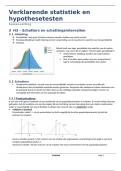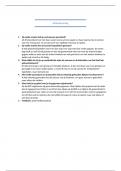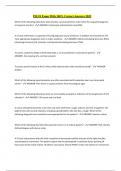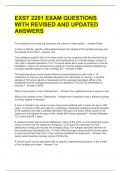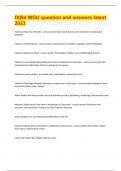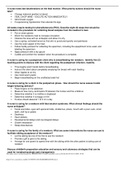WEEK 1
Lecture 1
Risks of marketing in emerging economies:
- Cultural clashes
- Politic instability
Understanding the differences and communicating the strengths of EEs = key!
We are going to use The Big Picture framework during the entire course.
Big Picture framework: used to identify the key marketing variables, prioritize problems, and
express/support solution. It is a toolset designed to improve business performance by lifting
the marketing competency of the firm. The framework changes the way managers approach,
analyze and solve business problems driving efficiency and effectiveness. This is organized
from a brand perspective.
Why?
1. Identify key marketing variables
2. Prioritize problems
3. Express / support solution
Knowledge clips:
Emerging economies
An emerging economy is one in which the country is becoming a developed nation often
driven by relatively high economic growth and a rapid expansion of trade and investment
flows.
EEs are home to a growing middle class of consumers – this can be attractive for investment.
As per capita income rise so too does saving and investment as a share of GDP.
This can stimulate further growth.
1
,5 synoptic points about emerging economies
1. The centre of gravity in the world economy is changing (south-east), where most
growth comes from emerging economies.
2. There is a global battle for talented and skilled people, open economies tend to do
better in the long run.
3. Fast-growing economies put more pressure on the environment but many are now
leading the way with renewable investment and research.
4. Fast-changing comparative advantage is likely to widen trade imbalances and fuel
protectionist sentiment.
5. Capital flows where the risk-adjusted expected returns are highest, which is a big
challenge to higher income and older advanced countries.
The growth of developing countries, their economies and their corporations is without a
doubt the most dynamic development of the economic world.
STP - Segmentation, targeting, positioning
Many companies make the same mistake: thinking anyone can be their customers
STP is a three-step process designed to identify the most profitable customers and then
tailor the marketing and products to the specific needs of those customers
Segmentation
Divide your market into groups/segments based on some criteria:
▪ Demographic (age, gender, income/education level)
▪ Geographic (country, region, urban/city area)
▪ Psychographic (lifestyle, hobbies, opinions, personal traits/attitudes, entrainment
choices)
▪ Behavioural (brand loyalty, usage)
Targeting
Targeting involves deciding which of the segments you’ve identified is the most attractive
Factors to consider:
▪ Size
▪ Profitability
2
, ▪ Ease of reach
Positioning
In this step you map out the different variables considered in the previous two steps and
then position your product differently to your competitors in the minds of your customers
Types of positioning:
▪ Functional (solving a problem, providing benefit)
▪ Symbolic (enhancing self-image/ego or belongingness needs: luxury cars)
▪ Experiential (focus is on those elements of product that connect emotionally with
customers)
Market positioning map is useful with different dimensions, compare your product with that
of competitors
Advantages of STP:
Allows you to increase sales by defining target market and position products directly at these
segments
Helps you avoid wasting money by advertising to the whole market
Helps you identify gaps in the market
Disadvantages of STP:
Costs can increase if you have to produce multiple versions of your product or service
Need to create different marketing campaigns and collateral for each segment
You may need different distribution channels to reach different customer segments
Positioning
Position your products to meet the needs of the target segment
What is a brand:
A proprietary trademark for specific product or service
A contract from the company to its customers; a promise of specific benefits, quality, and
value. A relationship
Ultimately, a brand is what consumers tell each other it is, not what we tell the consumer it
is.
It is not about telling and selling. It is about bring a relationship mind-set to everything we
do.
Some examples of positioning statements
Apple computers offer… the best personal computing experience to students, educators,
creative professionals and consumers around the world through its innovative hardware,
software and internet offerings
Target segment: students, educators, creative professionals for whom
Point of difference: innovative reason to buy
Frame of reference: personal computing experience points of parity
IBM… for businesses who need computers, IBM is the company you can trust for all of your
needs
Positioning statement defines the value proposition of product to the target market.
Positioning is implemented through all elements of the marketing mix: 4Ps
3
, Should focus on a few key benefits – unique selling proposition
Position must be defensible
Positioning requires making choices
The role of positioning
Point of parity / frame of reference (part of positioning statement)
Associations that are not unique to the brand, they are shared with other brands
Category POPS: associations consumer views as necessary to be considered credible
Example: grocery store must have certain products to be truly considered a grocery store
Competitive POPs: associations designed to negate competitors point of difference
Point of difference (POD)
Strong, favourable, unique brand associations
Similar to notion of USP (unique selling point)
SCA: sustainable competitive advantage (achieve and advantage in the marketplace for a
prolonged period of time)
May involve: performance attributes, benefits, imagery associations
POD criteria
Are POD desirable to the customer?
Is it relevant?
Is it distinctive?
Can you deliver POD to the customer?
Feasibility (affordable? Possible?)
Communicability (evidence to communicate?
Sustainability (internal commitment)
4

